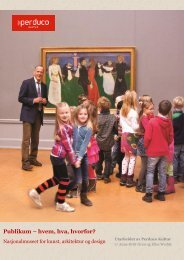Arts audiences: insight [PDF 6.5 MB] - Arts Council England
Arts audiences: insight [PDF 6.5 MB] - Arts Council England
Arts audiences: insight [PDF 6.5 MB] - Arts Council England
- No tags were found...
You also want an ePaper? Increase the reach of your titles
YUMPU automatically turns print PDFs into web optimized ePapers that Google loves.
About the segmentation research<strong>Arts</strong> <strong>Council</strong> <strong>England</strong> works to enableeveryone to experience arts that enrichtheir lives. To help achieve this we work inpartnership with artists, arts organisations,local authorities and others to find newways to excite, engage and inspire people.To inform this work, we have developeda new arts-based segmentation ofEnglish adults. This research looks at artsengagement across a very broad spectrumof arts events and activities, from opera toknitting, carnivals to video art.‘Segmentation’ is a market researchmethod where a given market is brokendown into distinct groups that behavein similar ways or have similar needs.Segmentation can help organisations tounderstand their markets, identify groupsof consumers they would like to target anddevelop products and communications thatanticipate their needs.The segmentation was conducted byEnlightenment (part of BMRB) in fourkey stages:• analysis of the patterns of artsengagement and attitudes towards thearts among English adults (aged 16 andover), based on data from Taking Part,a large-scale national survey of culturalparticipation• identification of 13 arts consumersegments• statistically-based fusion of Taking Partwith Target Group Index (TGI) survey• use of Taking Part and TGI data to profilethe 13 segments, providing informationon socio-demographic characteristics,lifestyle habits, media profile andattitudesWhy segmentation researchis important for the artsSegmentation is relevant to thearts because:• not all people are the same, or share thesame attitudes, opinions and motivationsabout the arts• people’s differing attitudes, opinions andmotivations shape behaviour – how andwhy people are likely to engage withthe arts• from a marketing perspective, a personfrom one segment can be responsive toone approach, while the same approachcan be wholly irrelevant to a person fromanother segmentSegmenting <strong>audiences</strong> is not a newapproach for many arts organisations,and is standard business practice formost commercial organisations. Differentorganisations adopt different methods forsegmenting different markets, depending ontheir needs. Our approach to segmentationhas three key features:• it covers all English adults, not justa particular audience group – thisenables artists and arts organisationsto understand their current <strong>audiences</strong>within the context of wider patterns ofarts engagement, and to think aboutpotential future <strong>audiences</strong>• it starts with the arts – existingpopulation-wide segmentation tools (egACORN and Mosaic) * are based largely onthe socio-demographic characteristics ofdifferent groups, while this segmentationis based on patterns of arts engagementand attitudes towards the arts. Ittherefore provides a tailored tool for artsmarketing in particular, allowing us toexplore socio-demographic and other04 <strong>Arts</strong> <strong>audiences</strong>: <strong>insight</strong>* Geodemographic classifications of consumer typesdeveloped by CACI (ACORN) and Experian (Mosaic).


![Arts audiences: insight [PDF 6.5 MB] - Arts Council England](https://img.yumpu.com/45899288/4/500x640/arts-audiences-insight-pdf-65-mb-arts-council-england.jpg)



